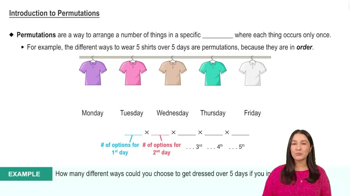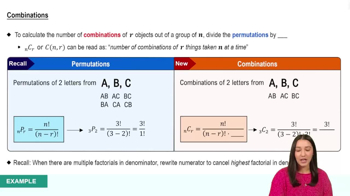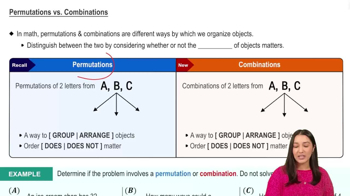Mendel’s Peas Mendel conducted some of his famous experiments with peas that were either smooth yellow plants or wrinkly green plants. If four peas are randomly selected from a batch consisting of four smooth yellow plants and four wrinkly green plants, find the probability that the four selected peas are of the same type.
Table of contents
- 1. Intro to Stats and Collecting Data1h 14m
- 2. Describing Data with Tables and Graphs1h 55m
- 3. Describing Data Numerically2h 5m
- 4. Probability2h 16m
- 5. Binomial Distribution & Discrete Random Variables3h 6m
- 6. Normal Distribution and Continuous Random Variables2h 11m
- 7. Sampling Distributions & Confidence Intervals: Mean3h 23m
- Sampling Distribution of the Sample Mean and Central Limit Theorem19m
- Distribution of Sample Mean - Excel23m
- Introduction to Confidence Intervals15m
- Confidence Intervals for Population Mean1h 18m
- Determining the Minimum Sample Size Required12m
- Finding Probabilities and T Critical Values - Excel28m
- Confidence Intervals for Population Means - Excel25m
- 8. Sampling Distributions & Confidence Intervals: Proportion1h 12m
- 9. Hypothesis Testing for One Sample3h 29m
- 10. Hypothesis Testing for Two Samples4h 50m
- Two Proportions1h 13m
- Two Proportions Hypothesis Test - Excel28m
- Two Means - Unknown, Unequal Variance1h 3m
- Two Means - Unknown Variances Hypothesis Test - Excel12m
- Two Means - Unknown, Equal Variance15m
- Two Means - Unknown, Equal Variances Hypothesis Test - Excel9m
- Two Means - Known Variance12m
- Two Means - Sigma Known Hypothesis Test - Excel21m
- Two Means - Matched Pairs (Dependent Samples)42m
- Matched Pairs Hypothesis Test - Excel12m
- 11. Correlation1h 6m
- 12. Regression1h 50m
- 13. Chi-Square Tests & Goodness of Fit1h 57m
- 14. ANOVA1h 57m
4. Probability
Counting
Problem 3.4.1
Textbook Question
1. When you calculate the number of permutations of n distinct objects taken r at a time, what are you counting? Give an example.
 Verified step by step guidance
Verified step by step guidance1
Understand the concept of permutations: Permutations refer to the arrangement of objects in a specific order. When calculating the number of permutations of n distinct objects taken r at a time, you are counting the number of possible ordered arrangements of r objects selected from a total of n objects.
Recall the formula for permutations: The number of permutations of n distinct objects taken r at a time is given by the formula P(n, r) = n! / (n - r)!, where '!' denotes factorial (the product of all positive integers up to that number).
Break down the formula: The numerator, n!, represents the total number of ways to arrange all n objects. The denominator, (n - r)!, removes the arrangements of the remaining (n - r) objects that are not selected, leaving only the arrangements of the r selected objects.
Provide an example: Suppose you have 5 distinct objects (A, B, C, D, E) and want to calculate the number of permutations when selecting 3 objects at a time. Using the formula, P(5, 3) = 5! / (5 - 3)!. This simplifies to 5! / 2!.
Explain the result conceptually: The result represents the total number of ways to arrange 3 objects (in a specific order) chosen from the 5 distinct objects. For example, one possible arrangement is (A, B, C), and another is (C, A, B).
 Verified video answer for a similar problem:
Verified video answer for a similar problem:This video solution was recommended by our tutors as helpful for the problem above
Video duration:
3mPlay a video:
Was this helpful?
Key Concepts
Here are the essential concepts you must grasp in order to answer the question correctly.
Permutations
Permutations refer to the different arrangements of a set of objects where the order matters. When calculating permutations of n distinct objects taken r at a time, you are counting the number of ways to arrange r objects selected from a total of n. For example, if you have three distinct letters A, B, and C, the permutations of 2 letters taken from these would include AB, AC, BA, BC, CA, and CB, totaling six arrangements.
Recommended video:

Introduction to Permutations
Factorial
The factorial of a non-negative integer n, denoted as n!, is the product of all positive integers up to n. It is a fundamental concept in combinatorics used to calculate permutations and combinations. For instance, 4! equals 4 × 3 × 2 × 1 = 24, which represents the total arrangements of four distinct objects.
Recommended video:

Combinations
Combination vs. Permutation
While both permutations and combinations deal with selecting items from a set, the key difference lies in the importance of order. Permutations consider the arrangement of selected items as significant, whereas combinations focus solely on the selection itself, disregarding order. For example, selecting the letters A and B is the same in combinations (AB) but different in permutations (AB vs. BA).
Recommended video:

Permutations vs. Combinations

 7:11m
7:11mWatch next
Master Introduction to Permutations with a bite sized video explanation from Patrick
Start learningRelated Videos
Related Practice
Textbook Question
